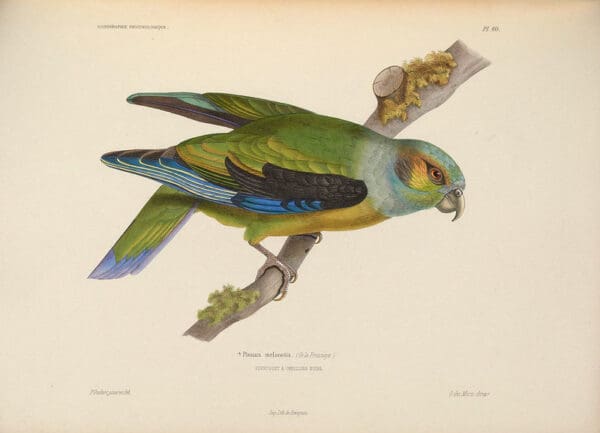Black-winged Parrot
Also known as:
Black-eared Parrot, Peruvian Black-winged Parrot (H.m. peruviana)
Also known as:
Black-eared Parrot, Peruvian Black-winged Parrot (H.m. peruviana)

Hapalopsittaca

melanotis
Size:
24 cm (9.4 in)
Weight:
Probably 125 g (4.4 oz)
Subspecies including nominate:
two: H.m. melanotis, H.m. peruviana
Colour Adult:
H.m. melanotis: Both adults mostly green; blue lores and frontal band; blue wash on crown and neck, with blue collar on area of neck; black ear coverts; black upper wing coverts and outermost secondaries; black inner secondaries edged with green on outer webs; green tail tipped with purple/blue. Beak blue/grey with horn coloured tip. Eye brown.
H.m. peruviana: Both adults brown/orange ear coverts; blue wash on foreneck restricted to thin band on throat.
Colour Juvenile:
H.m. melanotis: Black upper wing coverts, widely edged with green.
Call:
Calls made in flight are rapid and repetitious notes.
More Information:
Content Sources:
CITES
BirdLife International
Cornell Lab of Ornithology/Birds of the World
Parrots: A Guide to Parrots of the World, Juniper and Parr, 1998
Parrots of the World, Forshaw, 2006. 2010 edition
Lexicon of Parrots, Thomas Arndt.
Captive Status:
Rare in aviculture.
Longevity:
—
Housing:
—
Diet:
—
Enrichment:
—
Nest Box Size:
—
Clutch Size:
Not recorded.
Fledging Age:
—
Hatch Weight:
—
Peak Weight:
—
Weaning Weight:
—
World Population:
Unknown but described as rare and patchily distributed. Decreasing.
IUCN Red List Status:
Least Concern
CITES Listing:
Appendix II
Threat Summary:
Not globally threatened. A BirdLife “restricted-range” species. This species is considered to have a medium dependency on forest habitat, and tree cover is estimated to have declined by 2.9% within its mapped range over the past three generations. As a precautionary measure, it is tentatively suspected that this deforestation may have led to a 1-19% decline in the species’ population over the same time frame.
Range:
H.m. melanotis: C-W Bolivia.
H.m. peruviana: C and S Peru.
Habitat:
Found up to 1500-3500 m (4920-11,480 ft) in humid montane forest in the upper subtropical and temperate zones, in tall forest and into boggy elfin growth, where there are fruiting trees.
Wild Diet:
Feeds on berries in forest canopy, with a strong preference for Gaiadendron sp. mistletoe.
Ecology and Behaviour:
Social, seen in pairs or small groups; occasionally in large flocks. Some seasonal movements in response to abundance of food. Keeps mainly to upper stages of canopy where difficult to detect amongst foliage.
Clutch and Egg Size:
Not recorded.
Breeding Season:
Not recorded.
Related Links:

![© Marc Athanase Parfait Œillet Des Murs [Public Domain] via Wikimedia Commons An illustration depicts a Black-winged Parrot perched on a branch](https://parrots.org/wp-content/uploads/2023/01/Black-winged-Parrot-100x100.jpg)